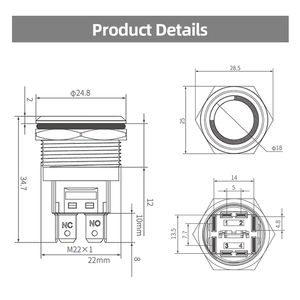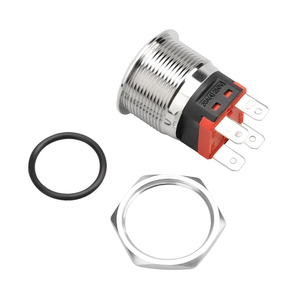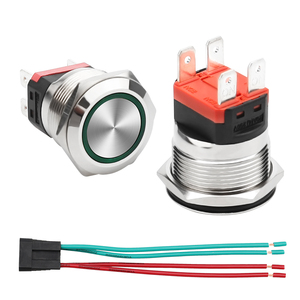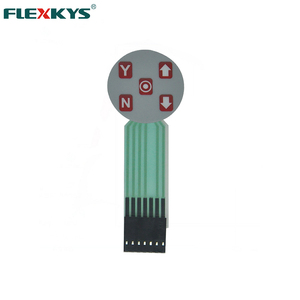
All categories
Featured selections
Trade Assurance
Buyer Central
Help Center
Get the app
Become a supplier

(5843 products available)



























Push button caps provide diversity to the buttons they are mounted on. Producers and dealers need to know the types since functionality is based on compatibility. Common types include:
These are dominant in most machinery. They provide full control of the button underlying systems. Solid-caps are known for the evenness of their surfaces as they help in the easy cleaning of the buttons.
Users of appliances requiring frequent operation, such as machinery and devices, prefer textured caps. The surfaces have grooves or ridges, thus enhanced grip, and their likelihood of slipping is lesser than that of smooth caps.
Emergency stop functions are found in the machinery with potential risk. These caps are typically red and immediately identifiable. Manufacturing these push buttons is a matter of safety compliance and dependability. Therefore, one should consider these features when choosing a supplier.
Illuminated caps are buttons that light up when operated or under specific conditions. These push button caps are used in many control panels and instruments to provide visual feedback.
Lockable caps ensure an operation that can only be performed by authorized personnel. The function of interlocking is indispensable in high-security zones or critical operations. For example, in defense systems.
Multi-functional caps can combine features like illumination, locking, or signaling. These caps are most suitable for compact devices where several functionalities are needed on one button. For example, on medical equipment.
The features of the caps depend on the materials used. Thus, users need to know which ones are suitable for certain situations. So, what materials offer what benefits?
Polycarbonate is also clear and highly impact-resistant, thus making it very appropriate for illuminated caps. It combines performance and safety; therefore, it is well-suited for use in areas with electrical components.
Silicone caps have flexibility and durability against heat and chemicals. This makes silicone the best material for protecting the buttons in the industries that deal with high temperatures or toxic substances. Moreover, silicone provides an elastic fit and is well-suited for anti-slip caps.
TPE is a rubbery thermoplastic that is highly durable and elastic. TPE is also resistant to many chemicals, including oil and grease. Because of these features, it is most applicable for caps in the automotive and medical industries. Its recyclability also contributes to sustainability.
ABS plastic is very popular for its robustness and affordability. An ABS plastic cap will typically feature a polished surface finish. These qualities make it appropriate for consumer electronics as they can resist daily wear, for instance, mobile phones. In addition, it is easy to license.
Alloy caps are extremely strong and rigid. They withstand stresses such as mechanical and environmental. In addition, they exhibit a premium finish that complements the high-end electrical enclosures. Acceptable alloys include aluminum and zinc. They are lightweight and do not corrode easily.
PP caps are lightweight yet tough, providing good protection against low or moderate levels of stress. Polypropylene is most used in low-power devices and closures and is commonly found in household appliances. Moreover, it is affordable and offers good value.
Choose wisely. Follow these three guidelines: functionality, quality, and compatibility.
One should understand the function of the button underneath when choosing the cap. What function does the operating button perform? For example, emergency red and textured solid caps, which offer a firm grip, are best to put over a safety function.
Quality is needed to achieve functionality. Only use high-quality materials that are resistant to wear, and they should fit properly. The production technique of this wear-resistant button cap must also guarantee long service and easy maintenance.
The push button cap has to be compatible with the operating conditions and the equipment. For instance, temperature range and pressure will determine the material to be used. Conducting an interdepartmental cap and button compatibility quiz is necessary for the correct match.
Manufacturers and distributors can increase their sales by understanding the various uses of these caps. Below are several applications for push button caps.
It's common to find machine caps in industrial machineries like lathes and drills. These ensure the buttons are protected from dust and debris while providing safety. For instance, emergency stop caps may prevent accidental operation in hazardous working environments.
Push button power caps are important for home electronics like TVs and microwaves. These devices use smooth or tactile textured buttons to enhance the design and make it easier to operate. These are also illumination caps that provide visual feedback.
Medical devices such as monitors and imaging machines use lockable or multi-functional caps to ensure proper operation. Multi-function caps are useful in medical devices where a single button might need different functions.
Automotive push button caps are located on dashboards, control panels, and other vehicle applications. TPE buttons are preferred because they can withstand temperature variations and frequent usage. Automotive push buttons appear on ignition systems, power windows, and other applications.
In the case of commercial kitchen appliances, such as ovens and dishwashers, push button telephone caps safeguard controls and are easy to clean. Also, they must be durable and in a shape that the staff can use when wearing protection for the hands.
Control panel push button caps function like a seal, preventing these buttons from electrical control panels. These may be smooth, textured, or lockable, enhancing panel aesthetics and protection.
A1: A push-button cap is a protective and functional cover for an operational button in various devices. The cap will safeguard, enhance, and ensure the button's proper functioning.
A2: These push-button caps are typically manufactured in silicon, thermoplastic elastomer, and metals. These materials have a degree of flexibility attached to them and a high resistance to wear and environmental factors.
A3: Yes, many industries use these caps. Machines, consumer electronics, vehicles, industrial enclosures, kitchen units, and control panels for electrical devices are applications for these caps.
A4: Choosing a supplier for these caps means being aware of the needs of the market. Which sorts of push buttons are people using presently, and what are the trends? Then, it is key to ensure that the supplier can guarantee the quality of materials and production, as they provide customizable products.
A5: Some cap manufacturers use eco-friendly materials such as polypropylene. Certain production methods, such as injection molding, can minimize waste, further enhancing the sustainability of the push button caps.